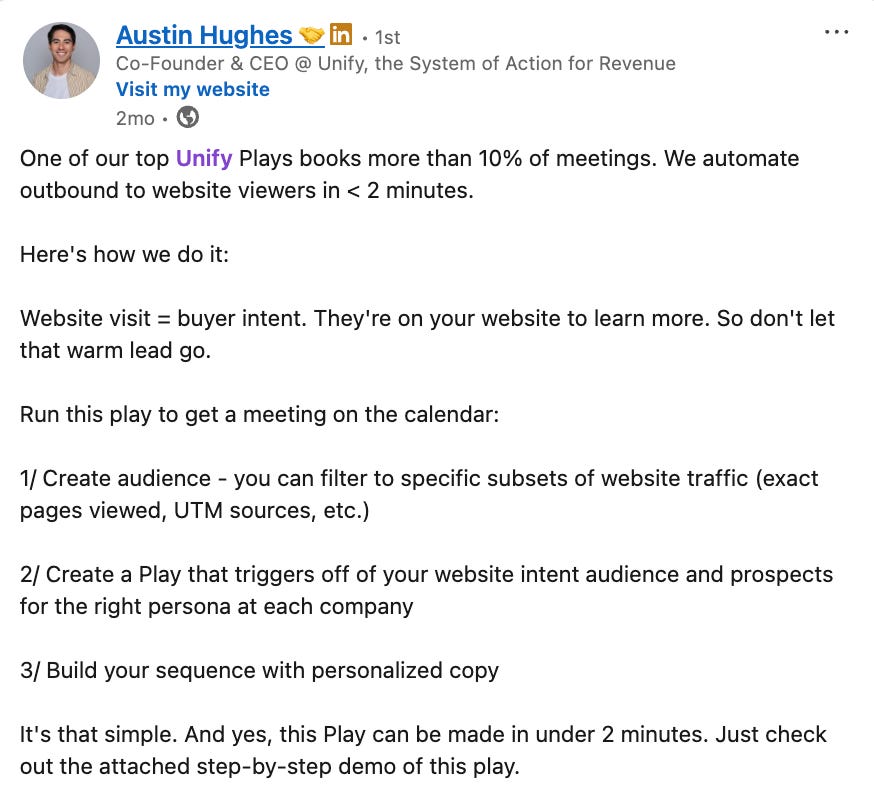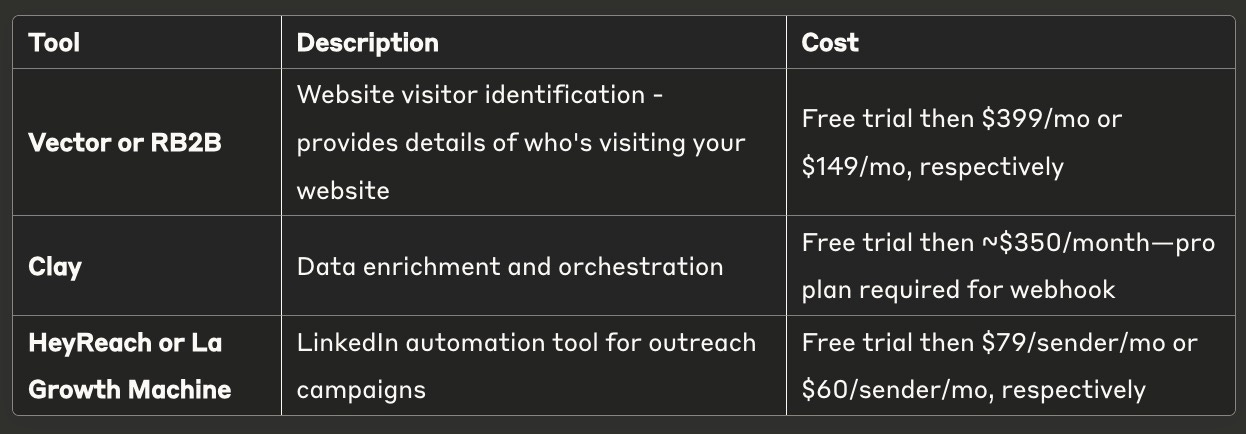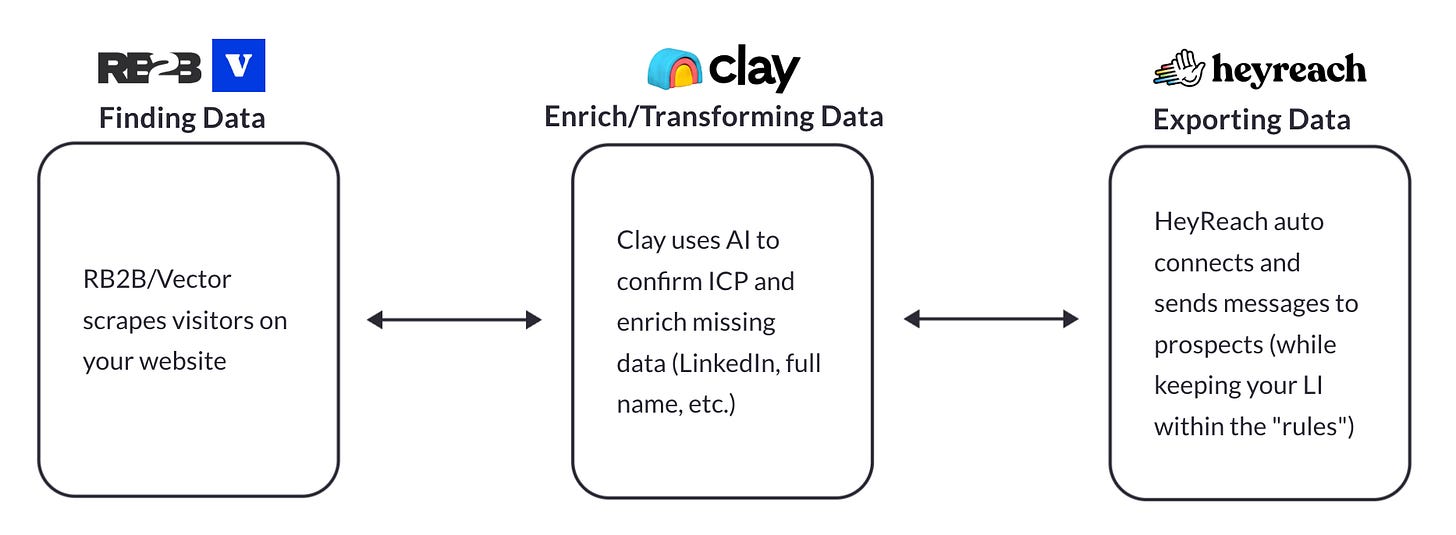Website-to-Outreach Play
Step-by-Step Breakdown
If you were forwarded this newsletter, join 4,552 weekly readers—some of the smartest GTM founders and operators—by subscribing here:
Hey y’all! 👋
I'm excited for today's post — it’s a collab with Chris Balestras, author of GTMBA.
I've known Chris for a while, and have been reading GTMBA for a few months now. Like most of the content I’ve been consuming as of late, it’s about the intersection of AI and GTM, specifically in startups. Chris is a former startup founder and GTM operator (most recently at Metronome) who nerds out on all things go-to-market.
Check out his newsletter: GTMBA.
Chris recently launched VibeScaling, with his partner, Cailen Dsa. It’s a GTM advisory firm that offers fractional sales, GTM engineering, recruiting, and throws events in SF and NYC. They've figured out how to find many of the best startups of the last couple of years (and managed to invest in early rounds). If you’re a pre-seed through series B startup looking for fractional sales and gtm engineering or recruiting, reach out to Chris at chris@vibescaling.ai or shoot him a message on LinkedIn.
Chris and I were catching up recently about what's been working in our respective GTM engineering engagements (he wrote about the Mount Rushmore of plays here), and he said the #1 play he’s using is: web intent → auto-messaging to help book meetings for the founding teams he's working with.
This is a classic play that every company with a decent amount of website traffic should be running. I run it with any engagement I'm doing. But, the devil's in the details in deploying this play correctly - and that's the alpha (not the signal itself). How you deploy a play matters even more than simply detecting a signal (or a bunch of signals, for that matter).
We wanted to do a deep dive as part of what we're calling the Alpha Archives — a spin on the GTM “alpha” term that Clay has popularized. These archives highlight ways to extract “alpha" from different go-to-market plays, showing you the "how” — exposing all the gory details.
In this post, you'll learn:
Why this play
What technology to use
The process to implement it
Messaging strategies and
Key tips to make this play most effective
Alright, let's get into it.
Why This Play
Back in April, I wrote 6 "Evergreen" GTM Plays (and the tools to run them). The purpose of that was to outline some of the most common plays that you should be running to capitalize on the lowest-hanging fruit of pipeline generation.
We're seeing this play consistently work for the startups we work with, as web intent from folks in your ICP is good enough intent to shoot personalized messaging to them through LinkedIn.
💬 Pro-tip #1: For early-stage startups (eg: seed through series B), I typically suggest sending this from a Founder or Exec’s LinkedIn account. It’s been proven that people will respond more to a higher title.
We're seeing reply rates of around 30-40% (if connected) and ~10% (if not connected). Compared to cold email’s low single-digit response rates, this play is a clear win for startups beginning to attract web traffic.
It's not just us that's seeing it — Austin Hughes at Unify mentions it as one of their top plays internally:

Shout-out to Unify, who just announced a Series B raise. I wrote a deep dive on them last week, and so did GTMBA.
More and more teams are realizing that this is a play they should be running, but the hard part is figuring out how to do it effectively. Unify starts at ~$17.5K (billed annually), and smaller teams don't have that budget (or the amount of web intent yet to justify that cost).
So, we wanted to show you a quick way to get this up and running for a fraction of that cost.
Tech To Use
The sales tech landscape is bloated, making it hard to determine what each tool actually does.
I'm all for consolidation when it makes sense, but for web intent de-anonymization, I usually recommend using a tool that is solely focused on this capability.
1. Website visitor de-anonymization
You’ll need to put a pixel on your website to capture (and de-anonymize) website visitors.
The two I've found to be best are Vector and RB2B. They both are dedicated to this, and de-anonymize on the company-level and the person-level.
💬 Pro-tip #2: Both of these tools only work with US-based traffic (because of GDPR compliance). They have a free trial, so use them for 2 weeks and see for yourself if it works for your market/amount of traffic. After Series B, you likely have a budget, resources, and a more complex team/CRM usage that demands a more comprehensive platform.
There are a lot of tools that do website de-anonymization (Apollo, Common Room, Pocus, UserGems, Warmly, Zoominfo), so maybe you’re already using something that has this as a feature.
Both Vector and RB2B offer an easy webhook integration into Clay.
2. Data enrichment + orchestration
You’ll need a data provider to enrich website visitors (company-level and person-level) and create filters (to only include good-fit companies, aka ICP and good-fit people, aka key buyer personas).
If you do choose to use Clay, there is a “cost” of a) learning how to use the tool (it’s complex, which has led to the rise of “Claygencies”) and b) Clay credits.
You can skip using Clay, but you’ll have less power/flexibility.
3. LinkedIn outreach
You'll also need a LinkedIn automation tool. I recommend HeyReach (or La Growth Machine) due to its easy UI and low cost, and you typically only need one seat to start. Word of caution: you should be extremely careful if you choose to fully automate this with a tool. They operate in a gray area around LinkedIn’s terms of use, so if you do use one, be conservative in the number of activities per day.
In this article, we’re going to focus on exclusively sending via LinkedIn (and no emails).
Total cost to get this up and running: $559/month
Process
Step #1 - Set up RB2B Account
Sign up here.
Then, set up a script on your website by going to “script" and following the walkthrough, so that there's a tracking stamp on your website from RB2B.
A walkthrough guide is available here.
Step #2 - Set up RB2B Webhook into Clay
This guide (created by RB2B) does the best job of explaining how to set this up, so you can fully work in Clay and see the web visitors come in.
I'd let this run for a few days to see 1) if this is even worth it for you, and then 2) what types of personas you're getting - this will help with the prompts.
Step #3 - Enrich in Clay
Patrick and Adam do a great job in this video of a walkthrough of how to set this up in Clay. I highly recommend checking it out.
💬 Pro-tip #3: Use Claude/ChatGPT to help make better prompts in Clay. Here is a prompt Chris has used with his clients.1
Then, filter in Clay: if “check”, write logic to send to (specified) HeyReach campaign.
Step #4 - Set Up HeyReach Campaign
Good walkthrough of how to do this here (made by the HeyReach team).
The one below is what I like using - a two-message campaign (I don't do three or more; sometimes I even send a single message).
Step #5 - Ship & Measure
Heyreach has a good dashboard to see incoming messages, stats on responses, etc:
34% connection rate, 39% message reply (from people you’re connected to), 9% InMail reply.
💬 Pro-tip #4: Set up Slack notifications so that no messages fall through the cracks (you can do this in the HeyReach “integrations” tab and set up your Slack instance to push pings as they come in).
Messaging
I look at a website visitor as an intent signal. This means, you can reach out to the person who was on the website, but also, other buyer personas at their company, too.
I do not like to mention that I saw them on the website in the outreach (I find that odd).
Example messaging below:
Hey! I've been noticing a lot of [target audience] are hitting the same wall with [specific pain point]. Most teams get stuck on [common obstacle] when trying to [desired outcome].
In an ideal world, you'd have [solution category] that just handles this seamlessly - curious how you're currently dealing with it? Open to me sending a 2 minute video on how we've helped similar companies tackle this?If I’m sending from a founder, I’ll even soften/shorten the message even more. Something like “Let me know if you want to jam on [relevant topic] and how I’m seeing other [buyer personas] solve this right now”.
I’m a big fan of CTAs that remove friction (like the above), as they are less taxing for a prospect than “free for 15 minutes to chat?" Remember, your goal of outbound is to start conversations (and convos create meetings).
💬 Pro-tip #5: Find a way to permissionlessly offer something of real value, for free. Asking someone if they want to see a 30-minute demo is so 2021.
Other Tips
Send it from the founders/c-suite as much as you can, as people answer people at a higher rate when they see they have that title.
Use OpenAI API for AI workflows for research/enrichment/messaging you build in Clay, which allows you to use it at a fraction of the cost.
Using Claude/ChatGPT to help create your Clay prompts is magic (and using Wispr Flow to dictate into these tools, even better).
Always use Clay to normalize company name/first name so that it doesn't come out with messaging that has someone's name in ALL CAPS or a format you wouldn't typically use, "Hey John J.,".
Be conservative with LinkedIn automation tools. This entire workflow can still work manually, if you prefer to er on the side of caution.
Set up Slack notifications on your engagement platform of choice (Heyreach in this example) so that you can see replies coming in as a consultant/employee and make sure you don't miss them.
PS: Bonus for you.
I created this Anthropic "Artifact" that you can customize/make your own guide for any play you want to generate this for — just reply in the thread with “create one for xyz” and have “xyz” be whatever play you’d like. The markdown file is already in there as the template. :) Happy building.
There you have it, folks. You just set up your first GTM engineering play, one that we've seen work effectively at any company with decent web intent.
Thanks to Chris, for helping write this post!
And again, go subscribe to the GTMBA newsletter and check out VibeScaling.
As always, thank you for your attention and trust.
Cheers,
Brendan 🫡
#CONTEXT#
You are tasked with qualifying prospects based on their LinkedIn profile to determine if they fit [client name] ideal customer profile (ICP) for [X] solutions. This analysis will determine whether to send a LinkedIn outreach message.
#OBJECTIVE#
Determine if the prospect works at a company that fits [client name] ICP and holds a technical AI or engineering role by analyzing their LinkedIn profile.
#INSTRUCTIONS#
1. Visit the prospect's LinkedIn profile using the URL provided in {LinkedIn Profile}
2. Analyze their current position and company to verify ALL of the following criteria:
**COMPANY SIZE ANALYSIS:**
- Check the company's LinkedIn page or "About" section for employee count.
- Look for indicators of company size such as:
- Multiple office locations listed
- Large number of employees visible in "People also viewed" or company page
- Enterprise-level partnerships mentioned
- Complex organizational structure with multiple departments
- Company must have 500+ employees.
**INDUSTRY VERIFICATION:**
- Verify the company operates in one of these target industries:
- Financial Services: Banks, investment firms, insurance companies, fintech, wealth management, trading firms, credit unions, mortgage companies
- Software/AI: SaaS companies, AI/ML companies, enterprise software, developer tools, cloud infrastructure, data platforms, cybersecurity
- Healthcare: Hospitals, health systems, pharmaceutical companies, medical device companies, healthcare technology, biotech, clinical research organizations
- Research Services: Market research firms, data analytics companies, consulting firms with technical research capabilities, and academic research institutions with commercial applications
- IT System Data Services: IT services companies, data processing companies, internet infrastructure providers, telecommunications companies, cloud service providers, managed service providers, systems integrators, technology consulting firms
- Tech-Forward Industries: Any company with significant technology focus, digital transformation initiatives, or technology-driven business models regardless of traditional industry classification
**TECHNICAL TITLE/PERSONA ANALYSIS - STRICT REQUIREMENTS:**
- Verify if the prospect's current title suggests they are in a technical AI, engineering, or product-related role.
- ONLY ACCEPT THESE SPECIFIC TECHNICAL PERSONAS:
- AI-Focused Technical Roles: Director of AI, Head of AI, AI Director, Chief AI Officer, VP of AI, Head of Generative AI, VP of AI Innovation, AI Strategy Lead, Enterprise AI Director, AI Transformation Lead, Head of AI Products, Director of AI/ML, AI/ML Engineering Director, Enterprise AI Lead, AI Program Director, GenAI Program Lead, AI Product Leader, Enterprise AI Architect, AI Solutions Architect, Chief AI Architect, AI Platform Architect, AI Engineering Lead, AI Infrastructure Architect, AI Integration Architect, AI Technical Lead
- Engineering-Focused Technical Roles: VP of Engineering, SVP/EVP of Engineering, Head of Engineering, Engineering Director, Chief Technology Officer (CTO), Chief Technical Officer, VP of Technology, Enterprise Architect, Principal Enterprise Architect, Technology Architect, Solution Architect, VP of Software Engineering, VP of Product Engineering, VP of Development, Head of Technology, Technology Director, Chief Innovation Officer, Chief Digital Officer
- Product-Focused Technical Roles: VP of Product Management, Chief Product Officer, Head of Product, Senior Director of Product Management, VP of Product Strategy, VP of Product & Engineering, Product Management Executive, Director of Product Management, Principal Product Manager, Senior Product Manager, Product Director, Head of Product Strategy
3. STRICT DISQUALIFYING FACTORS:
- NON-TECHNICAL ROLES (AUTOMATICALLY DISQUALIFY): Sales, Marketing, Business Development, Account Management, Customer Success, HR, Finance, Operations, Legal, Compliance, Communications, Public Relations
- Company has fewer than 500 employees
- Industry is not financial services, software/AI, healthcare, research services, IT system data services, or tech-forward
- Title suggests business/commercial focus rather than technical (e.g., "Business," "Commercial," "Revenue," "Growth," "Sales")
- Profile indicates they are a consultant, contractor, or not a full-time employee
- Company appears to be a small startup, agency, or pure services firm
4. ADDITIONAL VERIFICATION:
- Check if the person is currently employed (not "Former" or "Ex-").
- Verify the company information is current and matches the website domain.
- Look for recent activity or updates that confirm active employment.
- Confirm the role has technical responsibilities, not just technical-sounding titles in non-technical contexts.
#OUTPUT#
Return "✓" if ALL three criteria are met (company size 500+, target industry, technical AI/Engineering/Product title). Return a blank string"" if ANY criterion is not met.
#EXAMPLES#
Qualifying Examples:
- Title: "VP of AI" at JPMorgan Chase (Financial Services, 250k+ employees) → "✓"
- Title: "Enterprise Architect" at Microsoft (Software, 220k+ employees) → "✓"
- Title: "Head of AI" at Pfizer (Healthcare, 79k+ employees) → "✓"
- Title: "CTO" at Nielsen (Research Services, 15k+ employees) → "✓"
- Title: "VP of Product Management" at Salesforce (Software, 70k+ employees) → "✓"
- Title: "Chief Product Officer" at IBM (IT System Data Services, 280k+ employees) → "✓"
Disqualifying Examples:
- Title: "VP of Sales" at Goldman Sachs →"" (non-technical role)
- Title: "Marketing Director" at Microsoft →"" (non-technical role)
- Title: "VP of Engineering" at 50-person startup →"" (too small)
- Title: "CTO" at retail company →"" (wrong industry)
- Title: "Business Development Manager" at Salesforce →"" (non-technical role)
- Title: "Head of Customer Success" at tech company →"" (non-technical role)
Example Input: {LinkedIn Profile}
Example Output: "✓" or""







Great post! I think there's an outbound calling opportunity here as well. Call within 30 minutes of website visit. Thoughts?